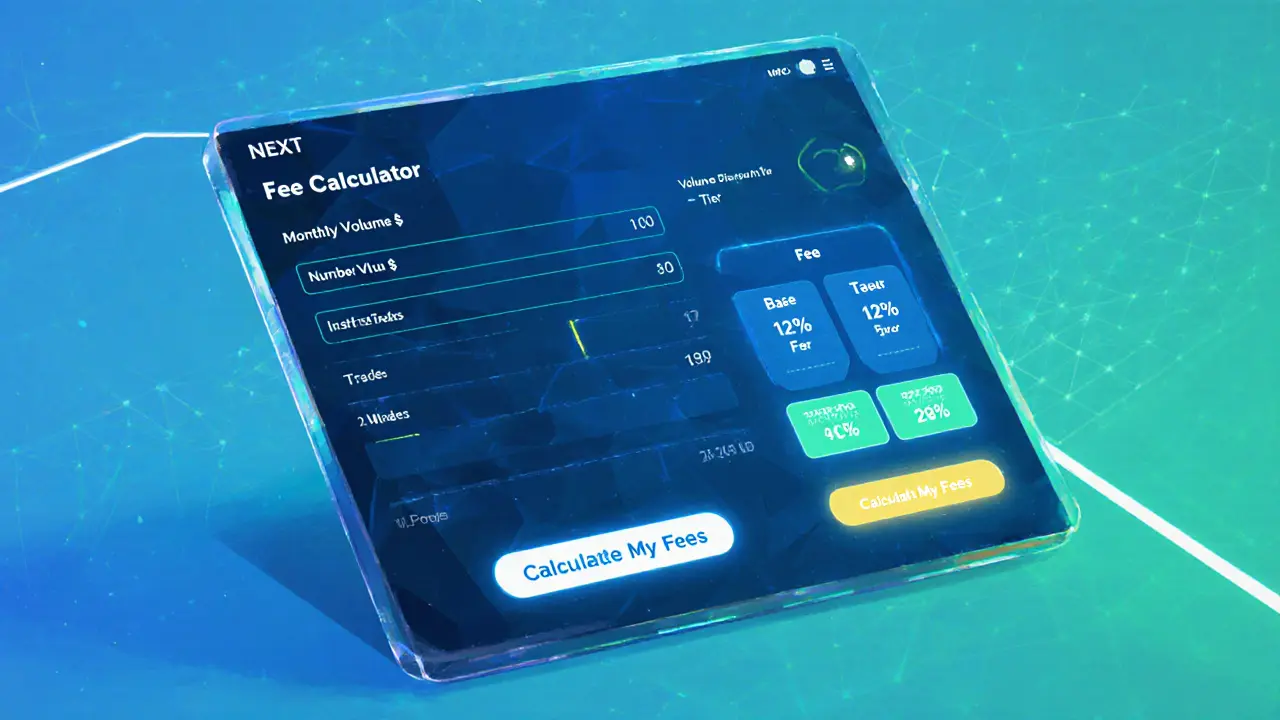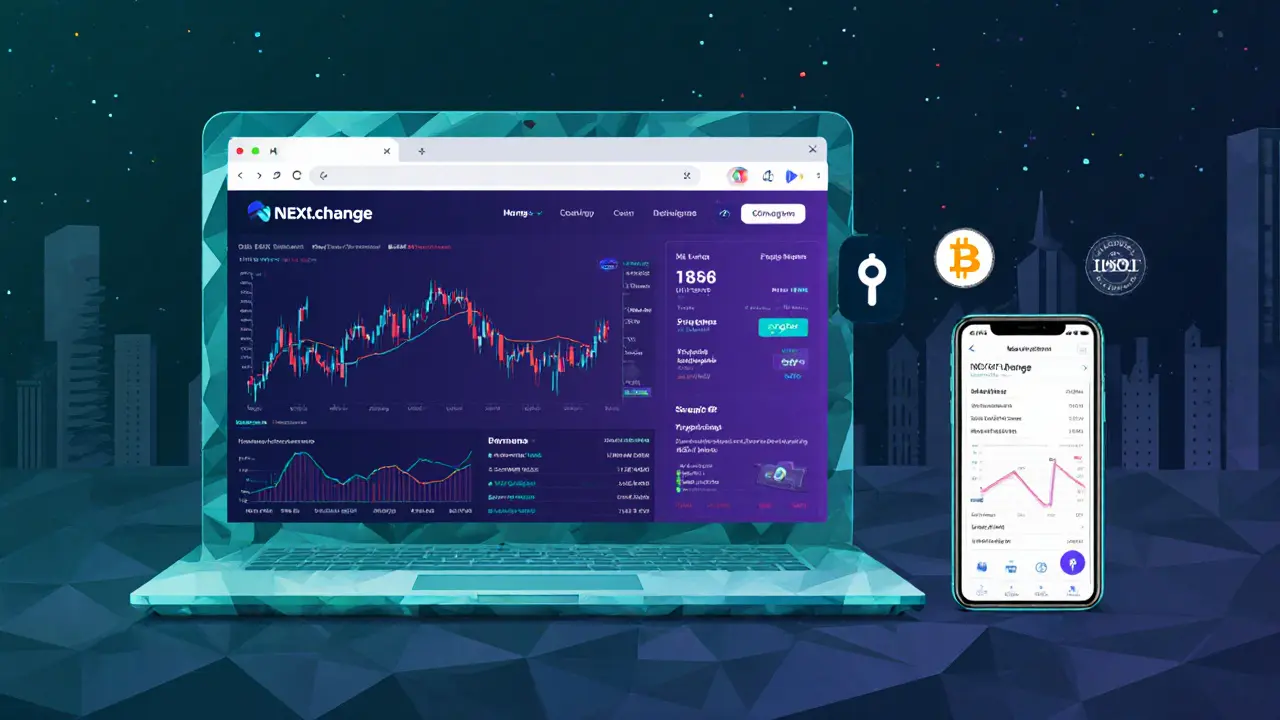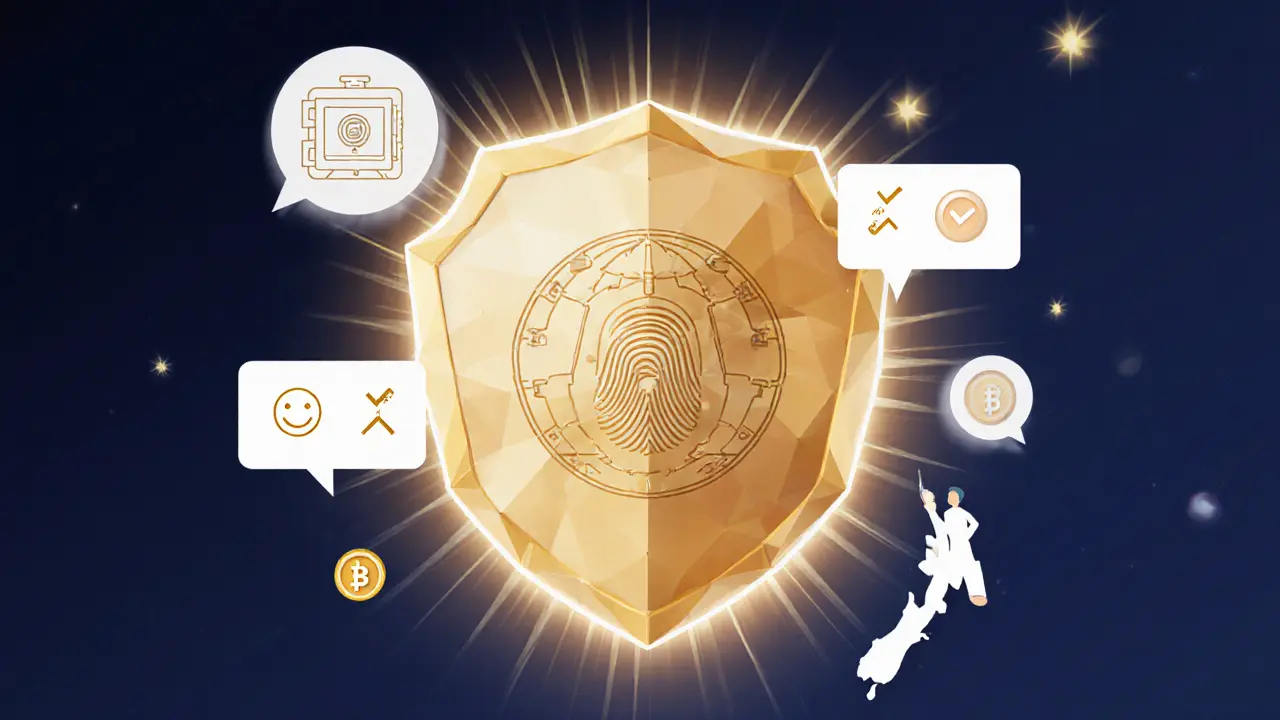NEXT.exchange Review 2025: Fees, Security, and Trading Features

NEXT.exchange Fee Calculator
Your Estimated Monthly Trading Fees
Base Tier
Maker Fee 0.10%
Taker Fee 0.15%
Volume Discount Tier
Maker Fee 0.05%
Taker Fee 0.07%
Estimated Monthly Cost
Quick Summary
- NEXT.exchange review shows a modern UI, decent liquidity, and a transparent fee schedule.
- Offers spot and limited futures trading on 120+ crypto assets.
- Security combines 2FA, cold‑storage wallets, and ISO‑27001‑aligned processes.
- KYC is streamlined but can be slow during peak sign‑up periods.
- Customer support is available 24/7 via chat and ticketing, though response time varies.
NEXT.exchange is a cryptocurrency exchange launched in 2022 that targets both retail traders and small institutional players. It positions itself as a low‑fee, high‑performance platform for spot trading, with a growing suite of futures contracts and staking options. While the name might not yet be as familiar as Coinbase or Kraken, the exchange has quietly built a user base of over 300,000 registered accounts as of Q32025.
What is NEXT.exchange?
In simple terms, NEXT.exchange is a cryptocurrency exchange that lets you buy, sell, and trade digital assets. It supports major coins like Bitcoin (BTC), Ethereum (ETH), and newer tokens such as Solana (SOL) and Polkadot (DOT). The platform also offers a small selection of crypto‑linked derivatives, mainly perpetual futures on the most liquid pairs.
Registration & KYC Process
Signing up starts with an email verification step, followed by a mandatory KYC (Know‑Your‑Customer) flow. The KYC module is built on a third‑party verification service that checks government‑issued ID, selfie verification, and address proof. Users typically receive a verification decision within 15‑30minutes, but during traffic spikes the wait can stretch to a few hours.
The compliance layer also includes AML (Anti‑Money‑Laundering) monitoring. Every transaction is scanned against global sanction lists, and unusual activity triggers a manual review. This dual KYC/AML approach aligns with regulatory expectations in the EU, Singapore, and NewZealand.
Trading Platform & Supported Assets
The web UI is built with React and offers a clean order‑book view, real‑time price charts, and quick‑trade widgets. Mobile apps for iOS and Android mirror the desktop experience, allowing you to place market, limit, and stop‑limit orders on the go.
As of October2025, spot trading covers 120+ cryptocurrencies, while futures trading is limited to 15 perpetual contracts with up to 20× leverage. The exchange also provides staking for a handful of PoS tokens, delivering yields between 3% and 7% APY.
Fees & Pricing
Fee transparency is one of NEXT.exchange’s selling points. The maker‑taker model starts at 0.10% maker and 0.15% taker for the base tier. Volume discounts kick in once you cross $1million in 30‑day trading volume, dropping the maker fee to 0.05% and taker fee to 0.07%.
Withdrawals incur a network fee that reflects the blockchain’s current congestion, plus a flat $2 service fee for fiat withdrawals to supported bank accounts. Deposits are free for most cryptocurrencies, but fiat deposits via ACH are subject to a 0.5% fee.

Security & Compliance
Security combines several layers:
- Two‑factor authentication (2FA) is mandatory for withdrawals and account‑settings changes.
- 90% of user funds are kept in offline cold storage, with the remainder in multi‑sig hot wallets.
- The platform undergoes regular penetration testing and holds an ISO‑27001‑aligned information‑security certification.
- All API keys can be restricted by IP and permission scope, protecting programmatic access.
In addition, NEXT.exchange participates in a bug‑bounty program that pays out up to $25,000 for verified vulnerabilities, demonstrating a proactive stance on security.
Mobile App & API
The iOS and Android apps provide real‑time price alerts, push notifications for order fills, and a native crypto‑wallet for quick deposits. The apps are built with native code, offering smoother performance than many web‑wrapper solutions.
For developers, the RESTful API supports market data, order management, and account‑balance queries. Rate limits are generous: 120 requests per second per IP, which is sufficient for most algorithmic trading strategies.
Customer Support & Community
Support is available 24/7 via live chat, email tickets, and a community forum. Average chat response time is under two minutes, while ticket resolution averages 6hours. The forum hosts active discussions on trading strategies, platform updates, and occasional AMA sessions with the engineering team.
Pros & Cons
- Pros
- Clear, tiered fee structure with real‑time volume discounts.
- Strong security: 2FA, cold storage, ISO‑27001 certification.
- Modern UI on web and mobile, plus a well‑documented API.
- Decent liquidity on top‑tier pairs, low slippage for most retail trades.
- Cons
- Futures offering is still limited compared to larger rivals.
- KYC verification can be slower during peak periods.
- Fiat on‑ramps are restricted to a few countries (EU, US, NZ).
How NEXT.exchange Stacks Up Against Major Rivals
| Feature | NEXT.exchange | Kraken | Coinbase |
|---|---|---|---|
| Spot assets | 120+ | 180+ | 250+ |
| Futures contracts | 15 (perpetual) | 50 (various) | 30 (US‑only) |
| Maker fee (base tier) | 0.10% | 0.16% | 0.50% |
| Taker fee (base tier) | 0.15% | 0.26% | 0.50% |
| 2FA required | Yes | Yes | Yes |
| Cold‑storage % of funds | 90% | 95% | 95% |
| Mobile app rating (Google Play) | 4.4 ★ | 4.2 ★ | 4.3 ★ |
| Supported fiat countries | EU, US, NZ | Global (70+) | 70+ |
The table shows that NEXT.exchange holds its own on fees and security while lagging slightly on asset breadth and futures depth. If you prioritize low taker fees and a sleek UI, it’s a strong contender.
Verdict: Who Should Use NEXT.exchange?
If you’re a retail trader looking for a clean interface, transparent fees, and solid security without the overhead of a massive exchange, NEXT.exchange fits the bill. It’s also a good stepping stone for traders who want API access before moving to more complex platforms.
Institutional players seeking deep futures markets or extensive fiat on‑ramps may find Kraken or larger players more suitable, but for everyday spot trading the exchange offers a compelling mix of price, performance, and support.

Frequently Asked Questions
Is NEXT.exchange regulated?
YES. NEXT.exchange is registered with financial authorities in the EU, Singapore, and NewZealand. It follows KYC/AML rules and holds an ISO‑27001‑aligned security certification.
What is the minimum deposit?
There is no minimum for crypto deposits. For fiat deposits via ACH, the minimum is $100.
Can I trade futures on NEXT.exchange?
YES, but the offering is limited to 15 perpetual contracts on the most liquid pairs, with up to 20× leverage.
How fast are withdrawals?
Crypto withdrawals are processed within 5‑30minutes, depending on network congestion. Fiat withdrawals to supported banks usually take 1‑3business days.
Is there a referral program?
YES. Referrers earn 10% of their referee’s trading fees for the first 30days, up to a maximum of $200 per referral.

Carl Robertson
March 23, 2025 AT 12:48Reading through the fee breakdown felt like watching a soap opera where every act tries to out‑dramize the last. They slap a 0.10% maker fee on the table, then whisper about a 0.05% discount once you magically hit a million dollars in volume. For a regular retail trader, that’s like waiting for a plot twist that never arrives. And the taker fee of 0.15%? It’s the equivalent of an extra commercial break that eats into your profit margin. Sure, the UI is shiny, but the real drama is whether you can actually save anything without trading the volume of a hedge fund. The security narrative sounds solid – 2FA, cold storage, ISO‑27001 – but it’s presented with the same theatrical flair as the fee story. Bottom line: if you’re not prepared to become a high‑frequency character, the fee drama might just be background noise.
Rajini N
March 24, 2025 AT 13:48For anyone just starting out, the fee calculator is a handy tool. Plug in your expected monthly volume and the estimated maker/taker costs appear instantly, which helps you plan realistic profit targets. The KYC flow is straightforward; typically you get verified within half an hour unless the platform is under heavy load. Security features like mandatory 2FA and the majority of funds in offline storage add a comforting layer of protection. Overall, NEXT.exchange offers a balanced mix of usability and safety for newcomers.
Kate Roberge
March 25, 2025 AT 14:48Honestly, the limited futures lineup makes the whole “institution‑grade” claim feel a bit pretentious.
Oreoluwa Towoju
March 26, 2025 AT 15:48The mobile app runs smooth and the push alerts are quick, which is great for staying on top of the market. Withdrawal times are decent, usually under half an hour for crypto. Just keep an eye on network fees during congestion.
Jason Brittin
March 27, 2025 AT 16:48Nice interface, but those fees still feel like a sneaky tax on every trade 😂. If you can push your volume high enough, the discount does help, otherwise it’s just another line item. The 24/7 chat is pretty fast, so at least you won’t be left hanging.
Amie Wilensky
March 28, 2025 AT 05:18Well, Carl, the fee structure is indeed transparent, albeit a tad complex, which can be confusing for newcomers, especially when juxtaposed with the platform’s sleek UI, and the volume‑based discounts, while attractive, require a trading frequency that many retail users simply don’t possess.
MD Razu
March 28, 2025 AT 17:48When you first glance at the fee table, the numbers seem modest, but the underlying mathematics quickly reveal a more nuanced picture. Maker fees of 0.10% are applied only when your limit orders add liquidity, which most casual traders rarely do. Conversely, the taker fee of 0.15% hits you on market orders, and since many users prefer the immediacy of market execution, that fee becomes the dominant cost. Now consider the volume discount: you need to surpass $1 million in thirty‑day turnover to halve those rates. For a trader handling a few thousand dollars a month, reaching that threshold would require an unrealistic number of trades. The platform’s calculator does a decent job of projecting costs, yet it assumes a static distribution of maker versus taker trades that may not reflect real‑world behavior. In practice, a typical retail user might see a maker‑taker split closer to 20‑80 rather than the 30‑70 model presented. That shift alone can increase the effective taker fee portion, eroding any perceived savings from the discount. Security, on the other hand, is undeniably robust, with two‑factor authentication and the majority of assets stored offline. The ISO‑27001 alignment provides an additional compliance veneer that many competitors lack. However, security features do not offset the cost structure for traders whose primary concern is minimizing fees. If you are a high‑frequency trader with sophisticated bots, the API rate limits and low latency could justify the platform’s fee model. For most retail participants, though, the incremental cost difference between NEXT.exchange and a rival with slightly higher fees but broader futures offerings may be negligible. Ultimately, the decision hinges on whether you value the clean UI and solid security more than a broader product suite. In that sense, NEXT.exchange occupies a middle ground that suits a specific niche of fee‑sensitive but volume‑light traders.
Charles Banks Jr.
March 29, 2025 AT 06:18The API docs are pretty thorough; you can fetch order book snapshots, place orders, and even set IP restrictions on keys. Rate limits of 120 requests per second are generous for most algo strategies, though you’ll want to batch calls to stay under the ceiling during peak spikes. If you integrate the REST endpoints with a WebSocket for live trades, you’ll get a near‑real‑time experience comparable to larger exchanges.
Ben Dwyer
March 29, 2025 AT 18:48Sounds like a solid starting point. The community forums also share sample scripts that can save a lot of time.
Lindsay Miller
March 30, 2025 AT 08:18The chat response speed definitely beats waiting on email.
Katrinka Scribner
March 31, 2025 AT 00:58I’ve been using NEXT.exchange for a couple of months, and the staking yields are surprisingly decent, especially on newer PoS tokens. The platform’s reward distribution is automated, so you don’t have to manually claim every week. One thing to watch out for is the network fee on withdrawals; during high congestion it can eat into the staking profit. Overall, it feels like a reliable place to park both trading and staking assets.
VICKIE MALBRUE
March 31, 2025 AT 09:18That optimism is refreshing; happy to hear the staking works smoothly for you!
Waynne Kilian
March 31, 2025 AT 17:38While the yields are nice, I wonder how sustainable they are if the platform suddenly changes its reward algorithm; a cautious approach is always wise.
Naomi Snelling
April 1, 2025 AT 10:18There’s a rumor that the “ISO‑27001‑aligned” badge is just a marketing ploy, and that the real data is being funneled to an offshore server farm. Some users claim they’ve seen delayed withdrawals right after a major hack on a different exchange, suggesting a coordinated effort to shake confidence. The KYC process could also be a backdoor for data harvesting, especially when the verification service is based in a jurisdiction with loose privacy laws. It’s worth keeping an eye on any sudden policy changes, as they might hint at deeper motives. If you value true anonymity, you might want to stay skeptical.
Michael Wilkinson
April 1, 2025 AT 22:48Even if those concerns are unfounded, staying vigilant and diversifying across multiple platforms is a smart defensive strategy.